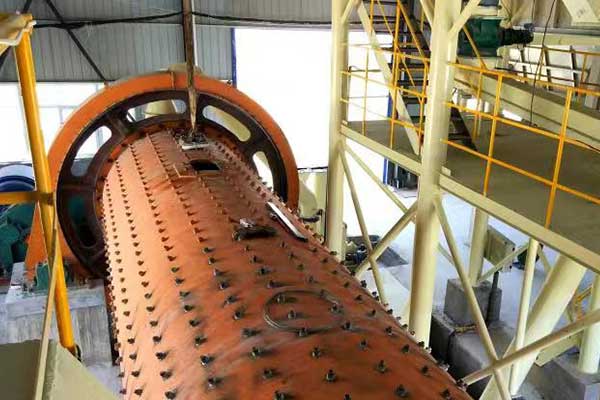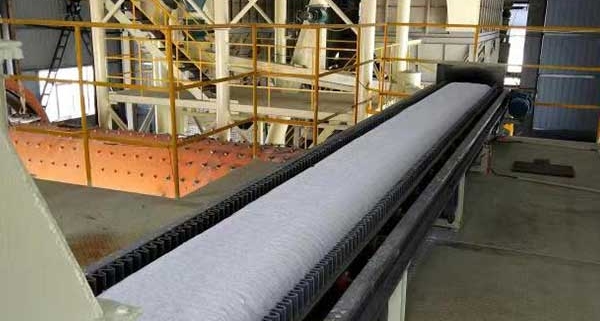Ⅰ.Raymond Mill+Classifier Technology
Raymond mill is a kind of crushing, which uses motor to drive the roller and centrifugal force to press the materials under low-speed conditions. It is accompanied by intermittent impact crushing. Raymond Mill has great advantages in terms of investment and energy consumption in the production of products below 400 mesh. However, the principle of grinding determines that the amount of micro-powder produced by Raymond mill is relatively small. For example, in 400 mesh fine powder, the proportion of micro-powder less than 10 micron is only about 36%. Usually, the Raymond mill is modified, or the superfine classification system is added. Ultrafine products of 800-1250 purposes can also be produced.
However, because of the low content of micro-powder, the production capacity of ultra-fine heavy calcium powder with more than 800 meshes produced by Raymond mill is on the low side.
Ⅱ.Dry Mixing Mill+Classifier Technology
Dry agitating mill is also called agitating ball mill. The mill body is a vertical cylinder with a stirring shaft in the middle, which generates grinding by rotating animal materials and media. Its grinding efficiency is high, and it is suitable for the production of ultra-fine heavy calcium over 1250 meshes, especially for the production of heavy calcium products over 2500 meshes, which is a very recommendable process.
Ⅲ.Vibration Mill+Classifier Technology
Vibration grinding is to use high frequency vibration to produce strong impact and grinding between grinding media and materials, thus crushing materials. Vibration grinding has high grinding efficiency, high content of fine powder in the output powder, and is more suitable for grinding more than 1250 mesh products. Vibration grinding has large diameter and serious over grinding phenomenon, so it is not a good choice for heavy calcium production.
Ⅳ.Ring Roller Milling+Classifier Technology
The mechanical structure and grinding mechanism of ring roller mill are similar to Raymond mill. They belong to centrifugal pressure of roller to feed material and grind. However, there are significant improvements in the structure of roller. The grinding efficiency of ring roller mill is much better than Raymond mill. It is mainly used to produce ultra-fine heavy calcium under 1500 meshes. At present, this kind of grinding equipment has been widely used in heavy calcium industry because of its low power saving and low investment. However, it is necessary to further study the output expansion of single mill. Compared with ball mill and vertical mill, the stability of its products is also worth studying.
Ⅴ.Technology of Vertical Mill+Classifier
The grinding mechanism of vertical roller mill (abbreviated as vertical mill) is similar to that of Raymond mill, which belongs to the grinding crushing. Because the pressure of roller is applied by high pressure hydraulic method, the grinding pressure of roller on material increases tens of times or even more, so its grinding efficiency is much better than Raymond mill. At present, it is one of the main equipments for large-scale production of heavy calcium.
Vertical mill is usually of two-roll structure, which is mainly used to produce powders below 400 mesh. Later, a three-roll vertical mill was developed, and the fine powder content was greatly improved, but it was generally preferable to produce products below 600 meshes at one time. After reforming the upper classifier, the ultrafine powder under 1250 meshes can be produced directly. In order to get finer products, 600-1000 mesh products produced by vertical mill can be used, and super-fine classifier can be used for secondary classification to produce more than 1250 mesh products. The investment cost of the equipment system is too high.
Ⅵ.Technology of Ball Mill+Classifier
The crushing principle of ball mill is that materials and grinding media impact and grind each other in the rotating process of ball mill. The output of fine grinding is lower than that of dry stirring mill and vibration mill, but higher than that of other crushing equipment. After modification in grinding, the grinding ability has been greatly improved, the content of fine powder is close to that of vibration grinding, and the phenomenon of over grinding is much lower than that of vibration grinding. At present, it is one of the main equipments for large-scale production of heavy calcium.
The technology of high-fine ball mill with classifier is strongly recommended by advanced powder technology companies in the world and widely adopted by famous Powder Companies in Europe and America. It is widely used in the processing of non-metallic ores such as calcite, barite, talc and kaolin. Taking the production of heavy calcium powder as an example, 600-6000 items can be produced, which is especially suitable for 800-2500 items. The production scale of single machine is 1-100,000 t/a. This production process fully conforms to the principle of producing low added value products of heavy calcium, requiring less investment, mature technology, simple process equipment, low energy consumption and higher output. The advantages of this scheme have been tested in practice.

The superfine powder production line designed by Luoyang Building Material Architectural Design and Research Institute uses ball mill + classifier technology, which produces the advantages of heavy calcium powder: uniform particle size distribution, continuous and stable batch, precise vertex cutting, spherical particles, large specific surface area, good filling effect, refractive effect number, especially suitable for high-end users.



